#drafting
Explore tagged Tumblr posts
Text
*In writing terms, an architect is someone who plots out, plans, and outlines things before drafting. A gardener is someone who takes an initial idea and then just writes, seeing how the idea grows without specific plans.
Some people use the terms “plotter” and “pantser” (as in, going by the seat of their pants) for these writing styles, but I prefer architect and gardener.
#writers of tumblr#writers on tumblr#writing polls#poll blog#pollblr#writer polls#writers#writing queue#tumblr polls#writing community#writing styles#outlining#drafting#creative writing#creative writers#architect#architect writer#gardener#gardener writer#plotter#pantser#go with the flow writing#pre-planned writing#writer community
2K notes
·
View notes
Text
I'm sure all the Bucky stans know this but there are a lot of us who don't so I need to say this and then shout it from the roof tops for the rest of you
During World War 2 in America the enlisted troops serial number started with 12 and the drafted troops started with 32
Bucky's serial number is 32557038 (yes I do know that off by heart)
His number starts with 32...
32.
Our boy was drafted, he didn't enlist and juding by the year he was probably drafted due to the Service and Enlistment Act
But did not choose to go to war, he was forced.
Just let that sink in
Because I cannot get over the fact that James Barnes never wanted to go to war, and Steve Rogers desperately wanted to be fit enough to enlist had swapped places
That parallel is insane
And I cannot believe that Marvel has never adressed the fact that Bucky went through all the shit he did because he was drafted. He didn't go in knowing the risks because he didn't choose to become a soldier, that choice was made for him, and thanks to the choice his life was a living hell since then
#bucky barnes#winter soldier#the winter soldier#james buchanan barnes#james bucky barnes#captain america#enlistment#drafting#world war 2#ww2#wwii history#wwii era#wwii#world war ii#ww2 history#marvel#mcu#marvel comics#james bucky buchanan barnes#serial number#32557038#marvel fact#wayward rambles#wayward rants#i lost my mind when i found this out
766 notes
·
View notes
Note
What do I do when the characters have chosen to go somewhere that makes sense, but leads absolutely nowhere?
I know exactly what you mean, and fixing it is certainly not impossible. It's pretty natural, especially if you're a pantser, to have your characters end up in a situation that wipes out all the tension. (It's easy to fall into this as a plotter too, so beware.) What you need to do is turn up the pressure in the plot, both externally and internally.
Possible Problem 1: Your Characters Are Too Comfortable. If your characters don't have enough internal conflict going on, they might just not want to move forward with the plot. This is a really easy hole to fall into (for all the stereotypes of writers tormenting their characters, I find it's much harder not to pull punches, especially with the first draft). Drive up that internal conflict within the characters and with each other. Laying down a subplot about an unrequited crush or a secret identity that implodes right when your characters feel safe can help get them going again. An argument between characters that causes them to do something reckless might be the catalyst you need.
Possible Problem 2: Not Enough Plot Tension. If your characters have lost steam, they may be in the wrong place. You may need to ramp up the danger by backtracking in the plot to lay down more external pressure to keep the characters going. A ticking clock fueled by the need to cure a deadly disease, a looming threat that's on their heels. If your characters still end up in a spot that too easily solves their problems, cut them off from getting there! The pass collapses, forcing them through the shadowy woods instead.
Possible Problem 3: You Don't Have the Next Plot Point Lined Up. If you're pantsing and are stuck (or if your outline isn't working), sometimes you just gotta take a moment to figure out where your characters actually need to be next and jump to that point. Sometimes writing out the next big scene will help you figure out how to build the connective tissue between them. Sometimes you will write "fix this later" and curse your past self into oblivion. We've all been there.
Possible Problem 4: You Might Just Need a (Short) Break. Truly stuck? Inspiration often strikes when you take your mind off the issue. Go for a walk, play a video game, try not to think of your writing issue for a couple of days. You'll likely realize the solution in the middle of doing something else.
Now, all of these techniques are for writing a story or a novel. If you're plotting out a game, you may just need to drop a Big Bad in the middle of things to force your characters into action. (Hell, you may need to do that for your novel too.) The most important thing is that no matter how clunkily you fix it, you can always go back and smooth over those rough parts with the power of hindsight.
311 notes
·
View notes
Text
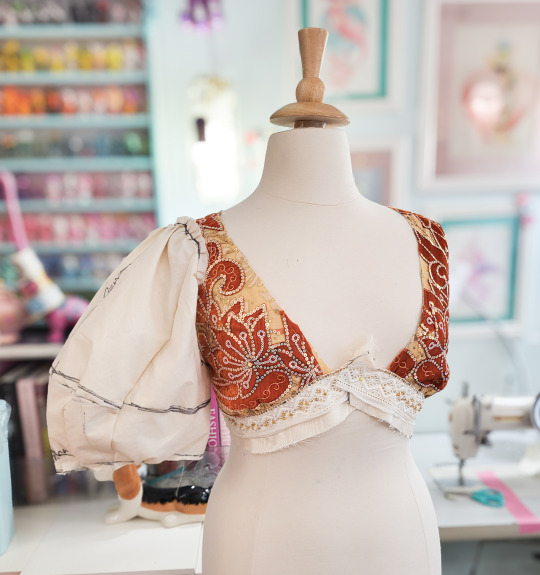

let's make some sleeves!
don't worry i'll put it below the cut, no one should be confronted with the horrors of drafting them on their dashboard without giving prior consent.
those first few photos are of the final mockup and the final sleeves. the first mockup was more to gauge length and the final width I wanted the cuff to have, so it looked like this.

I wanted this to have a specific lantern shape with limited gathers because this fabric is thicc so I sewed a 1/2" dart at each of the marked points, taking the bottom edge in by 11" in the process.

I ended up shortening it a lot just above where the darts ended, which left me with this.


I knew it would be easier to have a single seam going horizontally than sewing a dozen darts into each one, so I was prepared for this development. I probably could have drafted something much closer to this from the start but I wouldn't want to seem too competant.

I took out a lot of volume on my next mockup and settled on something very similar to what you see above.
then they were cut out from faille, the seam was covered with 1/2" horsehair braid to give them a bit more body.
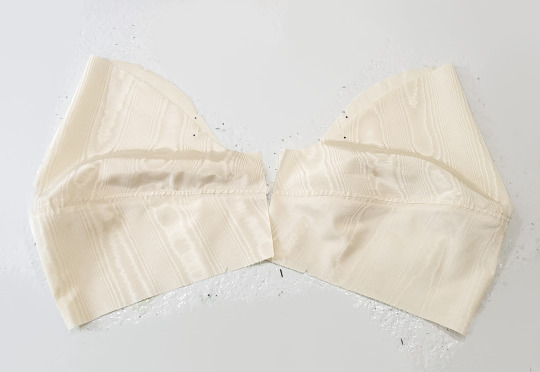
now, for the velvet layer, I didn't want a visible seam. It sort of ruins the flow of the fabric's pattern AND the fabric's pattern runs in vertical stripes which don't lend themselves well to the curves of the sleeves.
so instead I fussy cut out pieces and overlapped them until they formed the correct shape without any obvious breaks.
It was only after I got these pinned and partially sewn that I realized I forgot to add the gold overlay beneath them and had to re-do it all.

I kept trying to machine-baste together the edges and the sleeves were like "no."
the faille folded over the seam point after I finished since the overlay was like 1/4" too short in some spots, because I didn't baste all the layers together before cutting them out and sewing them together (like I usually do).
I ended up doing it by hand, all but two of the "short spots" will be hidden in seams and the others were patched with additional appliques.

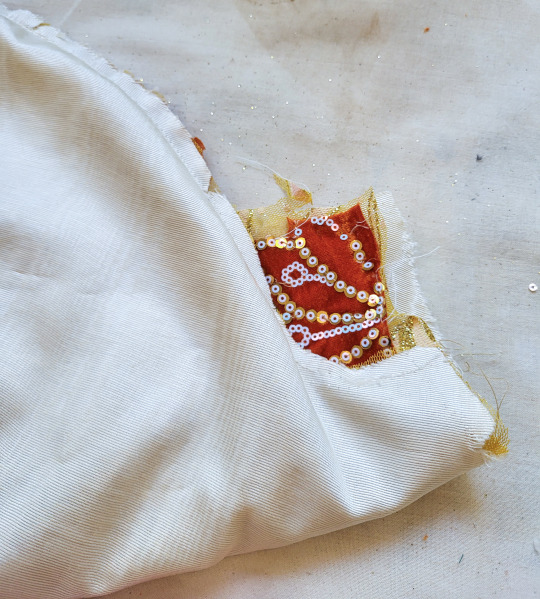
I sewed the appliques to the fabric below the horizontal seam, but this created issues with the drape when I attempted to carry it further up, so the layers are independent above that seam point, save for the top edge where they are basted/eventually seamed onto the bodice..
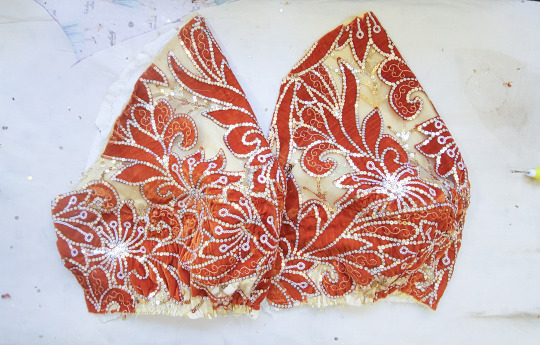
these will be finished with matching cuffs and cotton lining.
the bottom edges were gathered from 22" down to 19" prior to the underarm seam being done up, so most of the shaping comes from the piecing, not the gathers.
(the top edge is gathered a similar amount at the armscye.)


When going to baste together the top edges I decided to shorten the lining by about an inch at the center and tapering down to nothing at the underarm. This forces the fashion layer to puff out a little bit more.
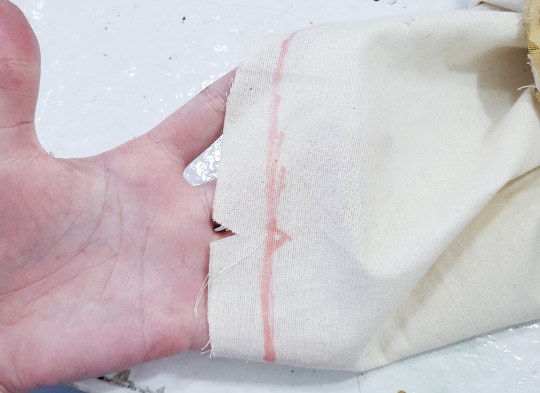

Then they were sewn on and probably some other stuff happened that I forgot. Anyway, voila!

318 notes
·
View notes
Text
It has recently occurred to me that to make a second draft after the first one I have to... rewrite the entire thing?? Not just, take the document and, edit ON IT, OVER it.
And that a first draft is not really supposed to be... readable?
Guys I need help,.how do you do drafts??
1K notes
·
View notes
Note
Hey, so i'm working on my first WIP, and i wanted to ask about drafting. When can one consider their first draft done? Does it have to have the goal word count (ie; 100K), or would being about halfway there be considered a good enough first draft, that i can move on to the second and start editing?
Concluding each stage of the writing process
It's difficult to know when a phase of a writing project has concluded and you're ready to focus on a new objective as it's developing. I tend to approach my writing projects with a clear and uniform trajectory, regardless of how diverse my projects can be. This approach allows me to remain focused, thorough, and reassured that I am covering all my bases in an organized fashion. However, it also maintains space for me to be explorative and intuitive when necessary. In regards to word count, I don't think it's entirely relevant unless you're determined to adhere to strict genre conventions. Give your story the space it needs and not an extra inch.
(Optional) Zero Draft
In this phase, you're telling yourself the story. You're doing it quickly, messily, intuitively, and forgivingly. Explore every idea that glows in the dark for you, don't throw anything away or discount any possibility. Exhaust your imagination in this phase so that when you reach the first draft, you know you're making informed decisions.
First Draft
You're crafting the structure and core elements of the story. This is often the phase of discovery. You're becoming acquainted with your characters and how they interact, you're beginning to feel at home in the world and settings you've built, and you're seeing all sides of the conflict as it evolves. The goal here is settle on a beginning, middle, and end point, and by the end of this process you want to know your characters' motivations and relationships inside and out.
Second Draft
Go back quickly through the first draft and address any points where you got stuck, where you compromised for the sake of carrying on to the end, and fill in any apparent blanks. The first time you really iron something out, there will always be a few pesky creases. This is the time to find and flatten them.
Third Draft
This is where you question everything. Identify and scrutinize your decisions, dive into the "curtains are blue" discussions with yourself, and begin to tidy up things like grammar, clumsy dialogue, over-poured descriptions, and dubious vocabulary. Comb through each paragraph and be brutal, prioritizing clarity and intentionality of how you've told the story.
The Read Through
This is the point where I recommend doing three things:
Letting it rest away from you for 1-3 months so that you can return to it with a bit of unfamiliarity and new perspective.
Hand it off to a couple of trusted readers and give them ample time to read, digest, and craft some feedback
Reread the project once all the way through making no changes (although annotations are acceptable)
Fourth Draft
Finishing touches. Vigorously and meticulously scrub and scrape between the lines and imagine giving it to your worst enemy. If you can imagine any mean (but valid) things they could conceive of to say about it, this is the time to grapple with or fix those details.
Additional Resources
Guide to Drafting
Word Count/Productivity Tracker Spreadsheet
Balancing Detail & Development
Writing The First Chapter
Writing The Middle of Your Story
Powering Through The Zero-Draft Phase
Writing The Last Chapter
Chapter Length
Happy drafting,
x Kate
597 notes
·
View notes
Text

Encyclopedia of American Architecture by Robert Packard and Balthazar Korab, Drafting Material Indications for Architectural Drawings
150 notes
·
View notes
Text


hand-drafts for weaving, posca pen on graph paper, 2022-2023
#going thru my own sketchbooks for inspiration >>>>>>>#my work#drafting#hand drafting#weaving#abstract art
68 notes
·
View notes
Text
my chaotic personal method for writing fun fictional stories
D&D style development for the characters, writing them down and letting them make their own choices for believable character motive and a chaos element.
World building should be fun and rough around the edges. Only explain the necessary bits. Never info dump.
Plot and story ideas written down and expanded until they connect plot points like a mad mind map that connects to one another in a 100 different ways
A running theme to connect your novels and stories. This helps keep the readers interest so they feel drawn to the next book like it’s a puzzle piece or clue
Different tropes & themes for all stories with a good mix of tragedy, romance, suspense, fun, humor, and adventure. Don’t let it get boring and stale! Keep moving through time, space, and human emotion.
No idea what to do next? Roll a die and let the character decide how to respond. 🎲
Plot holes? My favorite sweater has them and your book should to! Answer all questions later in the series, but leave a few to the readers imagination. Some things should be explored and discussed independently. What would they do? Is that really how that character would behave? Let them draw their own conclusions.
Don’t let your audience have all the juicy details in the first book. Make them question your delicately crafted reality and give them something to remind them.
Like every time they hear “biscuits and gravy” they think of your character Elizabeth that runs the inn and always has spectacular biscuits and gravy. Some biscuits and gravy are worth killing over. Real world meets fictional universe and gives the reader something to grasp.
Over all, remember, you’re creating something fun, and it should be fun to create.
Give readers something (or someone) to believe in. Then, break their hearts if you must.
☕️
If you enjoyed this post, please follow along! I’ll be sharing fun dialogue prompts, updates, and snippets of story ideas with my tumblr friends exclusively!
⚡️ email club coming soon ⚡️
Xx Until Next Time!
#creative writing#writers on tumblr#writerscommunity#writeblr#fiction#character development#writing prompt#novel writing#writing#write a line#writer stuff#female writers#writer blog#writerslife#writer things#writer problems#rough draft#drafting#plot twist#outline#a03 writer#dialogue prompt#tropes#writing trope#booklr#books and reading#book review#bookblr#book blog#author
56 notes
·
View notes
Text


New blueprint design!
#blueprint#drafting#mechanical design#robot#robogirl#gynoid#scifi art#science fiction#printmaking#retro future#retro scifi
36 notes
·
View notes
Text
I just finished drafting my third book, a novella, and I don't have anyone else to share it with so I'm sharing with all of you.
It's a ghost story and a love story. Sapphic, set in the 90s. Beautiful, and sad. I love it so much my heart might burst, and I am so so proud and so insanely happy.
I hope you all have the best day possible. Even if things aren't the best out there right now, I hope you find tiny sparks of hope and joy and cling to them all the tighter.
29 notes
·
View notes
Text
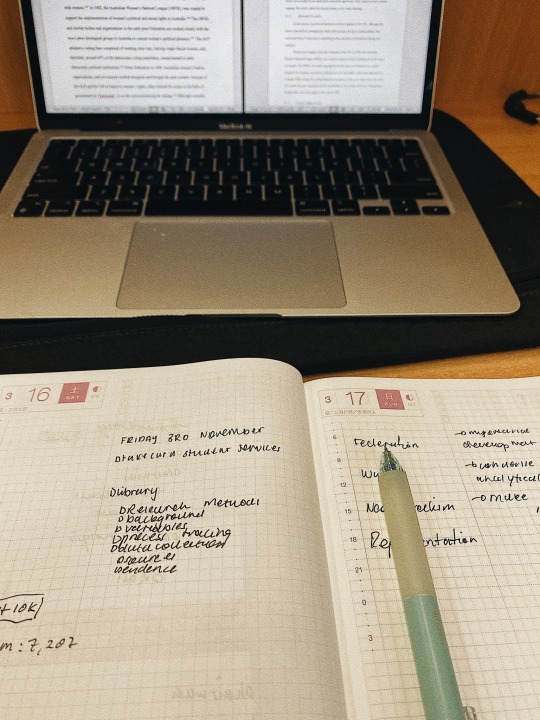

04.11.2023—been struggling with motivation recently, but it’s been getting better. so close to the finish line
#studyblr#studyspo#study notes#study motivation#bullet journal#study blog#athenastudying#stationery#studying#study#library#dark academia#heysucculent#heyxmissxjude#heyscholarly#heyaltin#thesis#writing#drafting#essays#heycazz#heychenleyah#heybeliada#heybirb#heybenni#heyiri#heyaestudier#productivity#college#university
297 notes
·
View notes
Note
Hello! I have a protagonist, I have her personality, internal goal, internal motivation, internal conflict, I have her character arc, knowing where she is at the start, middle and end of the story in terms of personal growth. But I am not sure how to execute it, I struggle with plot. I don't always know how I am going execute this character arc. What type of scenes could work for this. How do you figure out how to execute a character arc and finding the plot?
This sounds like you have a great internal plot without knowing the external kick-off, and believe me, I've been in the same boat. I just wrapped up a story that's been percolating for years in my brain, but obviously, you don't want to wait years!
Figure out genre and type. First, you need to figure out what genre you want to tell this story in. Take a look at your bookshelf or recent check-outs and think about what stories you gravitate toward. If it's sci-fi, is it giant space operas or telling very human stories about androids? If it's fantasy, what do you seem to prefer? Cosy mystery or hard detective novel? By type, are you a multi-narrative reader, or do you prefer a more focused first person account? Would you feel more comfortable writing for teens or adults? Even if you pick one thing and switch to another later, really sitting down and thinking about it is going to give you a guideline on how to carry out the story.
Nail down the inciting event. The starting plot of most stories goes something like this: your main character lives in their ordinary world, and then something suddenly shakes that up. It can be a break-up. It can be a dragon. It can happen before the novel starts, and your character explains how they got there afterwards. Regardless, something turns your character's life upside down and they're not going to find any peace until they undergo that internal journey you've laid out for them - with some prodding from the external plot.
Tie the external journal to the internal one. I'm saying this like it is easy, but trust me, I know it isn't. You've got one track of the story figured out, though, and that's half the battle. You character needs to change, and you know how. The external plot is you building scenarios and situations that will spur this change onward. Needing a fake date for the prom spirals into complicated situations in which your character realizes she's in love with her fake date, or figures out he's an evil alien plotting to take over the world. The drama is what you make of it.
Don't worry about getting it right the first time around. The first version of my story involved a completely different make-up of characters and situations. It went through a few shake-ups before settling down into what it is now. The only thing that remained integral to the plot is a cranky ferret. Don't let this scare you away! It's a natural part of the process, when writing, to deviate from what you originally conceived. You will end up with a better and more satisfying story by the end of the process.
When it comes to knuckling down and writing, I highly recommend finding a plot structure you like and following it for the first draft. That doesn't mean you have to stick with that structure, but it's a great way to figure out how to tie the external plot to the internal one. You can also check out the following tags:
Plotting
Outlining
Plot
Organization
Subplots
External Conflict
Internal Conflict
Drafting
64 notes
·
View notes
Photo

Greetings From The House Of Weyhe, 1929. Howard Norton Cook, 1901-1980. Pencil Woodcut Engraving on Washi paper.
620 notes
·
View notes
Text
Keep going
...even when the draft feels bad. That just means you've refined your eye for what makes "good" writing. You can always edit later!
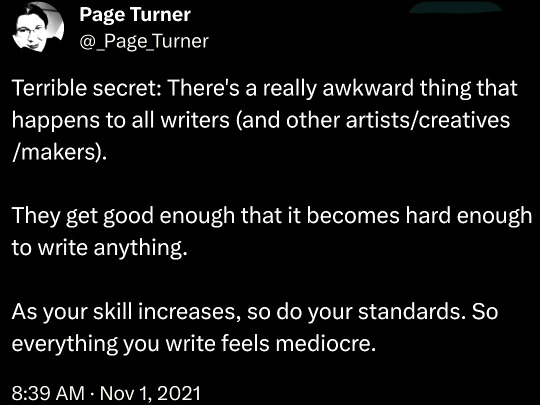
Terrible secret: There's a really awkward thing that happens to all writers (and other artists/creatives/makers). They get good enough that it becomes hard to write anything. As your skill increases, so do your standards. So everything you write feels mediocre.
The weird part is that this "mediocre" writing is far better than what you were writing before. You have just moved the goalposts on yourself as you improved. So you have to learn to give yourself permission to write anything. Even if you think it's bad.
What usually happens at that point is that you either:
A) end up not writing badly at all and surprising yourself with what you manage to produce, or
B) create something that has issues but is easily editable later on into something that meets your standards.
But wow, is it a gnarly adjustment to ignore that emotional reflex of "this sucks, I suck" and press on anyway.
I do find myself frequently wondering how many writers reach this awkward phase, believe wrongly that they suck, and never write again - just at the point when they're starting to get good! I'd imagine A LOT of them.
And no, this doesn't just happen with writing. It happens with every kind of artist and craftsperson. People tend to quit just as they're getting good, because their standards have raised along with their skills.
You've got this.
source tweet thread: X
285 notes
·
View notes